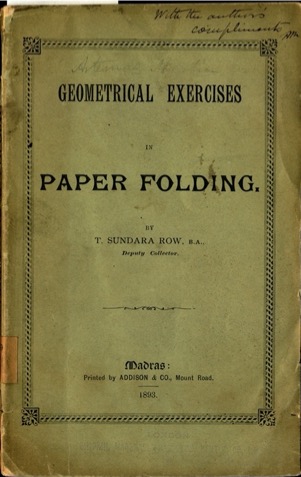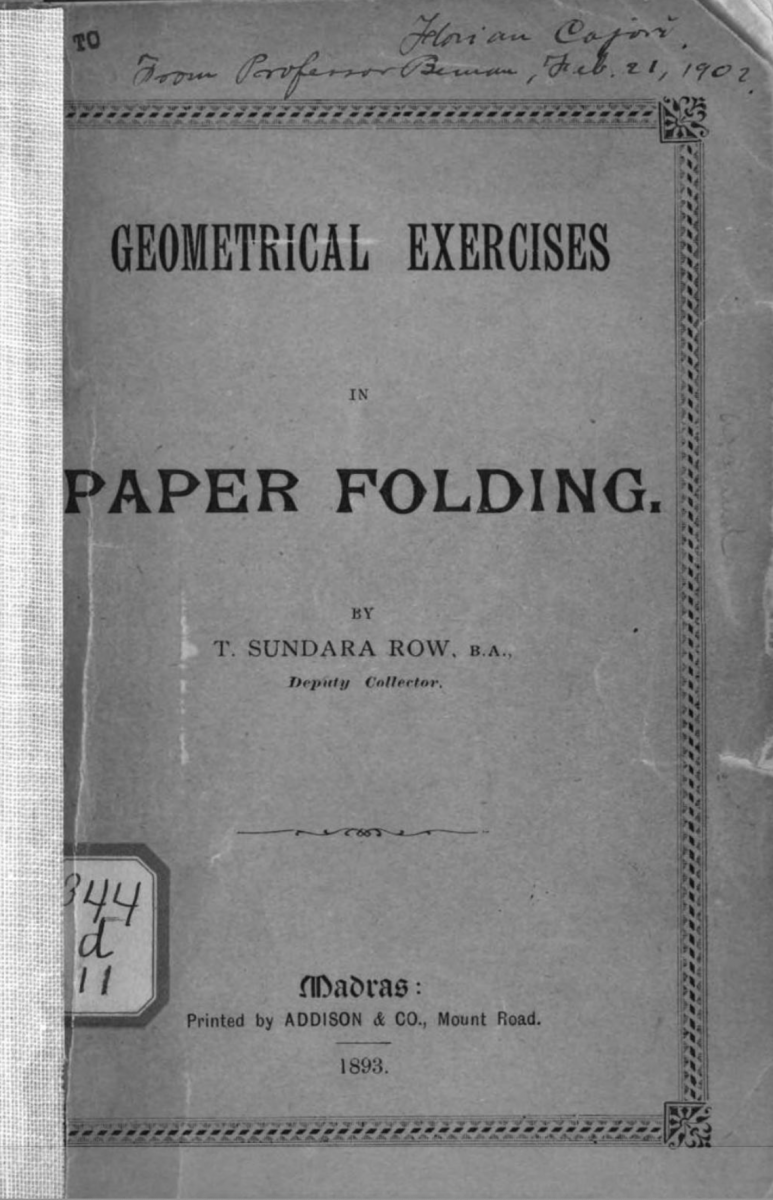- About MAA
- Membership
- MAA Publications
- Periodicals
- Blogs
- MAA Book Series
- MAA Press (an imprint of the AMS)
- MAA Notes
- MAA Reviews
- Mathematical Communication
- Information for Libraries
- Author Resources
- Advertise with MAA
- Meetings
- Competitions
- Programs
- Communities
- MAA Sections
- SIGMAA
- MAA Connect
- Students
- MAA Awards
- Awards Booklets
- Writing Awards
- Teaching Awards
- Service Awards
- Research Awards
- Lecture Awards
- Putnam Competition Individual and Team Winners
- D. E. Shaw Group AMC 8 Awards & Certificates
- Maryam Mirzakhani AMC 10 A Awards & Certificates
- Two Sigma AMC 10 B Awards & Certificates
- Jane Street AMC 12 A Awards & Certificates
- Akamai AMC 12 B Awards & Certificates
- High School Teachers
- News
You are here
Aiding the Teaching of Geometry and Affording Mathematical Recreation: Paper Folding in the Spirit of Sundara Rao of Madras
Mathematical recreations are often assumed to consist of toys, games, and puzzles, such as the Chinese tangram, Rubik’s Cube, or magic squares. However, this field also includes other delightful activities that include mathematical components but typically fall within realms such as magic, visual art, or handcrafts. Indeed, the MAA’s Special Interest Group on Recreational Mathematics defines its charge broadly. Similarly, paper folding is both an enjoyable pastime—as millions of origami aficionados can attest—and a longstanding technique for teaching geometry to audiences from small children to adults in various locations around the world.
This article traces the history of paper folding in mathematics education, from its origins in the German kindergarten movement through its recognition as “a new and very simple method of effecting certain [geometric] constructions” by Felix Klein [1897, p. 42]. I focus particularly on the 1893 text Geometrical Exercises in Paper Folding, written by Sundara Rao (1853–after 1923; his name was often spelled “Row” on his publications) of Madras, India, while that country was a colony of Great Britain. Inspired in part by efforts to reform the teaching of geometry in the British Empire, the book then gained readers in the United States as that nation was rising to global prominence. The story thus not only sheds light on an episode in the teaching of geometry, but also helps readers make connections between mathematics and world history and geopolitics. Additionally, mathematics instructors will find outlines for a few classroom activities based on Rao’s book that are suitable for use in precalculus, geometry, and history of mathematics courses, as well as capstone seminars and in-service workshops aimed at the preparation and professional development of secondary mathematics teachers.


Figure 1. Two of the surviving copies of Rao’s book were owned by significant 19th-century American mathematicians: Artemas Martin (1835–1918) and Florian Cajori (1859–1930). W. W. Beman’s interest in the work is explored later in the article. Note also the alternative spelling of Rao’s name (Row). American University and GoogleBooks.
Peggy Aldrich Kidwell (National Museum of American History, Smithsonian Institution), "Aiding the Teaching of Geometry and Affording Mathematical Recreation: Paper Folding in the Spirit of Sundara Rao of Madras," Convergence (March 2023), DOI:10.4169/20230313




